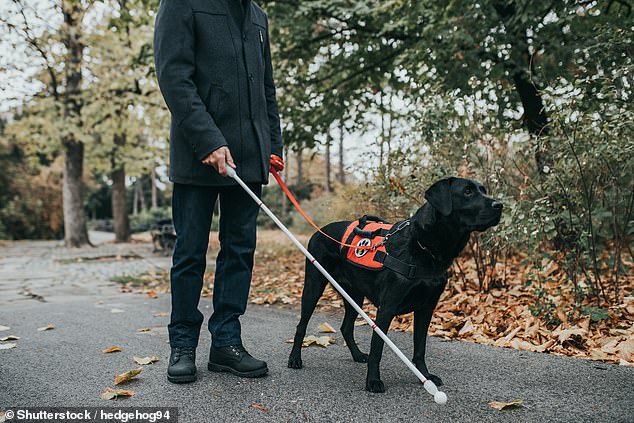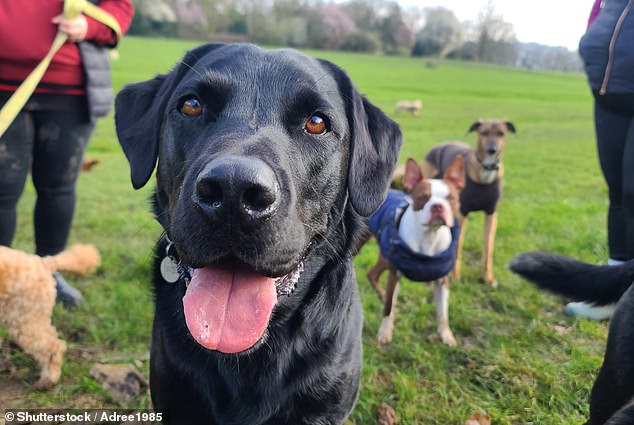There may be a new wave of domestication occurring in dogs, driven by people’s preference for pets that are affectionate, gentle, and adaptable to living in one place.
In the past, dogs were primarily viewed as working animals, responsible for tasks such as controlling pest populations, managing livestock, and protecting their living spaces.
priority for pet owners.
Research has revealed that this shift has resulted in higher levels of a hormone associated with social bonding in dogs, and particularly in service dogs.
Research has discovered that the hormone oxytocin is what motivates dogs to eagerly seek interaction with their human companions.
Researchers suggest that, just like humans domesticated wolves into the loving companions we know today, canines have developed a heightened sensitivity to oxytocin, often referred to as the ‘love hormone’.
The study, conducted by researchers at Sweden’s Linköping University in 2017, examined how dogs developed their distinctive capacity to collaborate with humans, including their tendency to ‘ask for help’ when confronted with a challenging problem.
Scientists speculated that the hormone oxytocin may be involved in social bonding, given its involvement in interpersonal relationships and interactions.
The way oxytocin works depends on how effectively it attaches to its receptor within cells.
Prior research has demonstrated that differences in genetic material situated near the gene responsible for coding oxytocin receptors have an impact on a dog’s capacity to communicate.
In other words, a dog’s social skills are partially encoded in their genetic makeup – particularly in the genes that regulate their sensitivity to oxytocin.
Researchers monitored 60 golden retrievers while they tried to remove a lid off a jar filled with treats, which had been designed to be beyond their reach.
They also collected nasal swabs from inside the dogs to determine their oxytocin receptor variants.

The dogs underwent this behavioral test twice: once following administration of oxytocin nasal spray, and once following administration of a saline nasal spray without any active ingredient.
The researchers timed the dogs to see how long it would take each animal to try and figure out the problem before deciding to seek assistance from their owner.
The results demonstrated that canines possessing a specific genetic variant of the receptor exhibited a heightened response to the oxytocin spray, in comparison to other dogs. Additionally, the oxytocin dose prompted these dogs to request assistance to a greater extent than the saline dose.
These results demonstrate insight into how domestication has modified the genes controlling dogs’ social abilities.
Experts on canine behavior, Brian Hare and Vanessa Woods, point out that dogs’ behavioral characteristics are currently undergoing a third wave of domestication.
As the role that these animals now fulfill in our lives has evolved from worker to companion, their behavior and possibly even their biology appears to be changing as well.
Mr. Woods is a professor of evolutionary anthropology at Duke University and oversees the Duke Canine Cognition Center. He supervises the Puppy Kindergarten program at the center, which provides training for young dogs to serve as service dogs.
This puppy kindergarten program also functions as a long-term research study to examine how various training methods affect a dog’s behavior and cognitive growth.
.
These dogs are highly skilled professionals who can assist their owner with various tasks, maintain a serene and quiet demeanor when not engaged in work, and possess an unusually friendly approachability.
“Service dogs behave unlike most pet dogs, as they are drawn to strangers and this is even evident in their behavior as puppies,” Woods and Hare observed.
These dogs’ biology has also changed with increasing friendliness, a development that occurred thousands of years ago.
These highly trained dogs perfectly represent the characteristics of the perfect pet companion. They smoothly integrate into the lives of their owners and into the ever-changing demands of the contemporary world.
‘Service dogs integrate into the life of their handler in a way that many able-bodied dog owners desire their pets to assimilate into theirs,’ Woods and Hare stated.
Just a few decades ago, dogs were perceived distinctly differently from how they’re viewed today. They were primarily working animals, utilized for jobs like hunting, herding, and serving as the guardians of their homes and the people within, conditioning them to be active and always alert.
Prior to the 1990s, dogs spent the majority of their time outdoors. Given the less dense urbanization that existed at the time, they had a vast amount of space available to roam and explore.
‘If your dog were to sleep on your bed, you would likely wake up infested with ticks or fleas,’ the researchers stated.

Today, many more dogs reside in densely populated regions, resulting in significantly more time spent indoors. Furthermore, they engage with unfamiliar dogs and humans more frequently.
This shift has led to behaviors that made dogs appealing to our ancestors becoming counterproductive, Woods and Hare wrote. For example, ‘guarding against unfamiliar people and animals might make a dog harder to take for a walk around the neighborhood.’
‘Dogs that are more energetic, excitable, fearful, or anxious than average are more likely to be surrendered to shelters, where they may face challenges in finding a new home,’ they pointed out.
Woods and Hare believe that these emerging societal demands are driving a third wave of domestication of canines, with service dogs being the most highly developed members of their pack.
These service dogs bear little resemblance to the average Labrador retriever, and what they possess goes beyond what’s typical in military working dogs or the average family Labrador.
“The distinction between Canine Companion dogs and pet dogs clearly illustrates how a population of dogs can diverge in less than 50 years,” they noted.
Domestication of canines originated between 40,000 and 14,000 years ago. Originally, humans who lived as gatherers started the process of domestication when they would habitually dispose of food waste on the perimeters of their dwelling areas.
Wolves that capitalized on this predictable, energy-rich food source gained a survival advantage, Woods and Hare note. “As a result, over generations, the animals’ attraction to humans overtook fear and aggression.”
A new wave of demand began after the Industrial Revolution. This was a period when the growing middle class sought out dogs that reflected the refined tastes and financial security of their owners.
This led Westerners to start breeding dogs for specific physical characteristics, ultimately resulting in the creation of most of the 200 dog breeds recognized by the American Kennel Club today, the researchers stated.
As we venture into a third wave of domestication – one that is more centered on tailoring dogs’ personalities to fit our modern society – Woods and Hare suggest that humans should proactively contribute to this process.
“For the happiness of dogs and their owners, humans must breed and train more dogs like service animals, embarking on a new wave of dog domestication to help them adapt to the new world we have created.’





